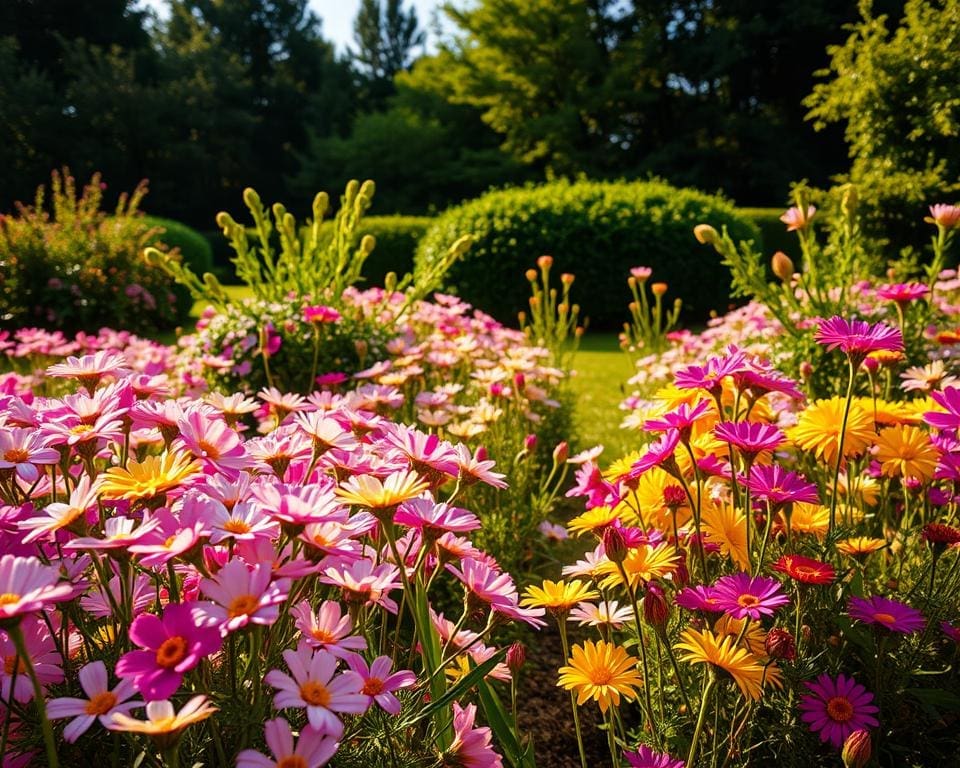Creating a flower garden that captivates both the eyes and the senses is an art. The combination of colours and scents can transform your outdoor space into a haven of beauty and relaxation. This article delves into the significance of garden aesthetics, exploring how to harmoniously blend vibrant colour combinations with fragrant flowers. You will discover inspiring design tips for flower gardens that not only appeal visually but also intrigue the nose. With the right mix of aromatic plants, your garden can become a sensory delight, helping you maximise its potential and enjoyment.
The Importance of Colour in Your Flower Garden
Colour plays a pivotal role in the overall design of your flower garden. Understanding colour theory allows gardeners to make informed choices that influence not only aesthetics but also emotional responses. Engaging with the principles of colour can lead to a delightful and vibrant space that resonates with the surrounding environment.
Understanding Colour Theory
At the heart of effective garden design lies colour theory, which encompasses the study of how colours interact. The colour wheel illustrates relationships between hues, allowing gardeners to explore complementary and analogous colour schemes. Warm colours, such as reds and yellows, can evoke feelings of excitement, while cool colours, including blues and greens, promote calmness. Grasping these concepts is essential for harnessing the emotional impact of colours in your garden.
Choosing a Colour Palette
Selecting a suitable colour palette tailored to your garden’s style can significantly enhance its visual appeal. Opt for a limited range of colours that complement each other, ensuring a cohesive and harmonious look. Consider these tips when deciding on your colour palette:
- Identify the focal point of your garden to centre your colour choices around it.
- Mix different shades and tones to add depth without overwhelming the senses.
- Utilise native plant species to enhance the natural beauty and maintain environmental harmony.
Creating Visual Harmony
Visual harmony is achieved through careful planning and arrangement, resulting in a garden that feels balanced and inviting. Incorporate the principles of garden design, ensuring that each colour contributes to the overall aesthetic. Pay attention to spacing and repetition of colours throughout the garden to tie different areas together. By focusing on visual harmony, the garden transcends mere colour choice and becomes a cohesive work of art.
How to combine colors and scents in your flower garden?
The delicate interplay of colours and scents can transform your garden into a sanctuary for the senses. When selecting fragrant flowers, consider how their colours harmonise with each other and their surroundings. Integrating seasonal scents not only enhances your garden’s visual appeal but also creates a captivating aromatic experience throughout the year.
Selecting Fragrant Flowers
Incorporating fragrant flowers is essential for creating a sensory gardening experience. Here are some popular options that offer both beauty and aroma:
- Roses: Known for their sumptuous fragrance, roses come in various colours, making them a staple in any garden.
- Lavender: This lovely purple flower offers a calming scent, perfect for a tranquil corner.
- Jasmine: With its sweet fragrance, jasmine can brighten up any garden space and attract pollinators.
- Peonies: Their lush blooms and delightful aroma add richness to spring gardens.
- Mock Orange: This shrub produces lovely white flowers and emits a refreshing scent reminiscent of citrus.
Seasonal Considerations for Scents
To maximise the sensory experience throughout the year, it’s crucial to plan for seasonal scents. Consider incorporating aromatic flowers for each season:
- Spring: Daffodils and hyacinths fill the air with sweet scents, signalling the arrival of warmer days.
- Summer: Embrace the vibrant fragrances of petunias and lilies for a sun-soaked scent combination.
- Autumn: Scented marigolds and asters offer a floral farewell to the season.
- Winter: Hellebores and winter jasmine can brighten up a cold garden with their subtle fragrances.
The Role of Scent in Your Garden
Scent plays a vital role in creating a sensory experience in gardening, enriching the overall atmosphere of any garden space. Incorporating aromatic plants can transform a regular garden into an enchanting haven, awakening the sense of smell and enhancing the enjoyment of seasonal blooms. Understanding how to choose these plants and layer their fragrances can elevate your garden fragrance planning.
Choosing Aromatic Plants
When selecting aromatic plants, consider a variety that includes herbs, flowers, and shrubs. Popular choices include:
- Lavender – Known for its calming scent, ideal for borders and pathways.
- Rosemary – Versatile in culinary use and smells delightful when brushed against.
- Jasmine – Famed for its strong, sweet fragrance, perfect for climbing up trellises.
- Mint – Provides a fresh burst of aroma, particularly effective in containers.
Incorporating a mix of those plants can result in a rich tapestry of scents, enhancing your garden’s appeal and drawing attention to its beauty.
Layering Scents Throughout the Seasons
Scent layering involves planting different aromatic species that bloom at various times of the year. This strategy ensures a continuous olfactory delight and creates various focal points within the garden. Aim for:
- Early spring blooms like primroses and hyacinths.
- Summer favourites such as peonies and lavender.
- Autumn treasures, including chrysanthemums and sedums.
- Wintergreens that release faint scents when crushed.
With careful garden fragrance planning, you can achieve a garden that not only looks beautiful but also engages all the senses. Create a timeline for planting aromatic plants, ensuring that their fragrances interweave and complement each other throughout the seasons.
Best Colour Combinations for Flower Gardens
Choosing the right colour combinations can significantly enhance the visual appeal of any flower garden. A thoughtfully arranged garden can evoke emotions and create a harmonious atmosphere. Gardeners can explore various strategies by understanding the dynamics of contrasting colours and complementary colours. Each approach offers unique benefits that can be tailored to personal style and the garden’s overall design.
Contrasting vs. Complementary Colours
Contrasting colours inject energy into a garden space. These bold colour schemes draw the eye and create an invigorating atmosphere. For example, pairing vibrant yellows with deep purples can create captivating visual interest. On the other hand, complementary colours produce a soothing effect, generating balance and harmony. Soft pinks alongside muted greens can create a peaceful and cohesive environment.
Heady Hues and Playful Pastels
Combining heady hues with playful pastels can add depth and intrigue to flower arrangements. Vibrant tones, such as fiery reds and bright oranges, command attention and stimulate the senses. Juxtaposing these bold shades with softer pastels, like gentle lilacs or serene blues, can soften the overall effect, making spaces more inviting. Pastel gardens often feel tranquil, while incorporating bold accents creates focal points that encourage exploration. Experimenting with various colour combinations will reveal the best fit for any garden aesthetic.
Creating Zones in Your Garden
Establishing distinct garden zones significantly enhances both aesthetics and sensory engagement. By thoughtfully designing interactive flower beds, one invites visitors to explore and appreciate the intricacies of nature. With well-organised flower arrangements based on colour and scent, you create pathways that guide the visitor’s experience, engaging their senses as they navigate through various garden design zones.
Interactive Flower Beds
Interactive flower beds offer a delightful opportunity for individuals to engage with the garden. The incorporation of diverse plant species encourages a multisensory experience, inviting everyone to touch vibrant blooms and inhale fragrant aromas. Assemble blooms by creating clusters of similar colours or scents while juxtaposing contrasting hues to stimulate visual interest. This design promotes exploration, as visitors naturally traverse the space, discovering hidden treasures within each garden zone.
Guiding the Nose and Eyes
Implementing sensory pathways within your garden encourages a harmonious journey. Visual and aromatic pathways entice visitors, leading them from one enchanting area to the next. To achieve this, consider using fragrant plants strategically positioned along paths. This method not only enhances scent but also draws attention to the surrounding foliage and flowers. By combining these elements, gardeners can design a cohesive environment that captivates the senses and creates memorable experiences for all who enter.
Maintaining a Balanced Garden Aesthetic
The journey of enhancing your flower garden doesn’t end with the planting phase; it requires ongoing effort and commitment. Garden maintenance is vital for preserving the harmonious blend of colour and fragrance you originally envisioned. Regular pruning, for instance, ensures that plants grow healthily and that the overall design remains cohesive. By keeping a sharp eye on the growth patterns of your flora, you can maintain balanced aesthetics that enhance the garden’s charm throughout the year.
Incorporating seasonal visual updates is equally important. As the seasons change, your garden can benefit from replanting certain areas with seasonal blooms that not only add colour but also invigorate the fragrant landscape. This aspect of garden maintenance allows you to keep the visual and aromatic appeal fresh, introducing new scents that entice the senses. Staying attuned to seasonal shifts will enable you to curate a garden that evolves beautifully over time.
Adopting sustainable gardening practices is essential for long-term garden planning. Composting garden waste and using organic fertilizers not only nourish the plants but also contribute to a healthier ecosystem. This mindful approach ensures that your garden is both aesthetically pleasing and environmentally responsible. By harmoniously melding visual delight with eco-friendly practices, your garden can thrive and become a serene sanctuary that endures the test of time.









